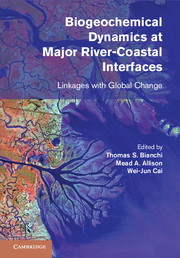12 results
Biogeochemical Dynamics at Major River-Coastal Interfaces - Half title page
-
- Book:
- Biogeochemical Dynamics at Major River-Coastal Interfaces
- Published online:
- 05 November 2013
- Print publication:
- 28 October 2013, pp i-i
-
- Chapter
- Export citation
Biogeochemical Dynamics at Major River-Coastal Interfaces - Title page
-
-
- Book:
- Biogeochemical Dynamics at Major River-Coastal Interfaces
- Published online:
- 05 November 2013
- Print publication:
- 28 October 2013, pp iii-iii
-
- Chapter
- Export citation
Contents
-
- Book:
- Biogeochemical Dynamics at Major River-Coastal Interfaces
- Published online:
- 05 November 2013
- Print publication:
- 28 October 2013, pp v-viii
-
- Chapter
- Export citation
Copyright page
-
- Book:
- Biogeochemical Dynamics at Major River-Coastal Interfaces
- Published online:
- 05 November 2013
- Print publication:
- 28 October 2013, pp iv-iv
-
- Chapter
- Export citation
Section I - Introduction
-
- Book:
- Biogeochemical Dynamics at Major River-Coastal Interfaces
- Published online:
- 05 November 2013
- Print publication:
- 28 October 2013, pp 1-18
-
- Chapter
- Export citation

Biogeochemical Dynamics at Major River-Coastal Interfaces
- Linkages with Global Change
-
- Published online:
- 05 November 2013
- Print publication:
- 28 October 2013
Preface
-
- Book:
- Biogeochemical Dynamics at Major River-Coastal Interfaces
- Published online:
- 05 November 2013
- Print publication:
- 28 October 2013, pp xiii-xiv
-
- Chapter
- Export citation
Section IV - Western hemisphere systems
-
- Book:
- Biogeochemical Dynamics at Major River-Coastal Interfaces
- Published online:
- 05 November 2013
- Print publication:
- 28 October 2013, pp 395-650
-
- Chapter
- Export citation
Dedication
-
- Book:
- Biogeochemical Dynamics at Major River-Coastal Interfaces
- Published online:
- 05 November 2013
- Print publication:
- 28 October 2013, pp ii-ii
-
- Chapter
- Export citation
Section II - Water and sediment dynamics from source to sink
-
- Book:
- Biogeochemical Dynamics at Major River-Coastal Interfaces
- Published online:
- 05 November 2013
- Print publication:
- 28 October 2013, pp 19-234
-
- Chapter
- Export citation
Index
-
- Book:
- Biogeochemical Dynamics at Major River-Coastal Interfaces
- Published online:
- 05 November 2013
- Print publication:
- 28 October 2013, pp 651-658
-
- Chapter
- Export citation
Section III - Eastern hemisphere systems
-
- Book:
- Biogeochemical Dynamics at Major River-Coastal Interfaces
- Published online:
- 05 November 2013
- Print publication:
- 28 October 2013, pp 235-394
-
- Chapter
- Export citation



